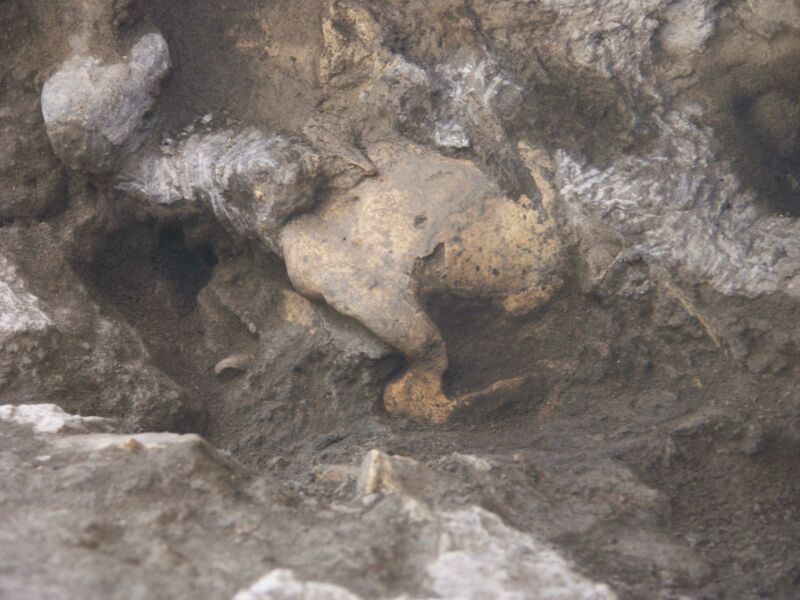
We have an extensive collection of fossils from the lineages that produced us humans. A large number of Australopithecus and early Homo skeletons track the transition to bipedal walking and the appearance of features that mark our present anatomy. But it's much harder to figure out what led to the mental capabilities—complex language, the near-constant use of tools, and so on—that help set humans apart.
Much harder—but not entirely impossible. Remains of skulls can help us figure out the likely cranial capacity of extinct species. And the brain actually leaves its mark on the interior of skulls, allowing some aspects of the brain's anatomy to be pieced together. Now, an international team has done this sort of analysis on a set of Homo erectus from a critical point in our species' past. They have found that some earlier brain species persisted well into the history of our genus Homo, but that didn't stop those ancestors from migrating out of Africa.
Reconstructing brains
How do you figure out what a brain once looked like? You need a reasonably intact skull, which is relatively rare, given the fragility of the bones. Once the skull is reconstructed, it's possible to make what's called an "endocast" of the interior of the skull, capturing the details of its features, including where it conformed to the underlying brain. In some cases, endocasts form naturally during the deposition of material around a fossil. They could also be made after discovery and now can be done virtually thanks to our ability to scan and reconstruct 3D volumes.
Obviously, there's a lot going on in the brain that isn't near its interface with the skull, and endocasts aren't going to be able to tell us about those changes. But if you look at endocasts of the brains of humans and our closest simian relatives, there are some clear diagnostic differences. One of the more significant ones is in an area called Broca's cap, which is associated with language abilities.
Lots of endocasts have been made over the years, and they show a pretty clear pattern. Early relatives like Australopiths retained the ape-like arrangement of the forebrain. More recent ancestors, like Homo erectus, had an arrangement that looked much more like what we have today. This led to the assumption that the modern arrangement evolved at the same time as our genus Homo appeared.
The new work extends our collection of endocasts to some critical skeletons: the Dmanisi hominins, which date to about 1.8 million years ago and were discovered in the Republic of Georgia. These are generally classified as members of Homo erectus, but they retain enough features of earlier species that this label remains controversial. The Dmanisi skeletons are interpreted as indications that Homo erectus expanded out of Africa very early, perhaps while its features were still in flux.
Redrawing the tree
The results are pretty clear: all five Dmanisi skulls show the earlier pattern of brain structure. That has a number of significant implications. It clearly means that the present-day brain structure did not originate with the genus Homo but only evolved after we'd been around for nearly a million years. In addition, the Dmanisi skeletons were found with a variety of stone tools, so we can infer that the modern brain structure wasn't a prerequisite for their development.
Finally, it also shows that our ancestors didn't need the present-day brain structure in order to spread far beyond their point of origin in Africa. In fact, it suggests that the relationship between our brains and migrations is extremely complicated because previous data, when incorporated into this analysis, indicates that the modern arrangement of the brain was in place by 1.5 million years ago—and appeared almost contemporaneously from Africa to Southeast Asia.
This suggests that our ancestors left Africa in multiple waves, some not separated by very much time, at least in evolutionary terms. And before this critical time period, the size of the brain (as opposed to its arrangement) was increasing gradually and steadily. (Albeit with some severe outliers like the Indonesian hobbits and Homo naledi, which were small-brained but very recent.)
Complicating matters further, the researchers note that there were much larger changes going on in facial morphology during this time, probably driven largely by diet. But there's no clear correlation between what was going on with the face and jaw and what was happening with the brain structure.
So while the new study clarifies a lot of questions and overturns a major assumption, there are limits to how much it can tell us. Although the brain region looked at here is associated with language, there's no way to tell if its appearance correlated with the use of language. Tool technologies changed at around the same time as the transition between brain structures, but it's impossible to tell if the two were related. And we can only guess at the selective pressures that drove the changes in the brain.
But one thing is clear: our ancestors' ability and desire to roam the world was present long before our current brain structure was in place.
Science, 2021. DOI: 10.1126/science.aaz0032 (About DOIs).
reader comments
48